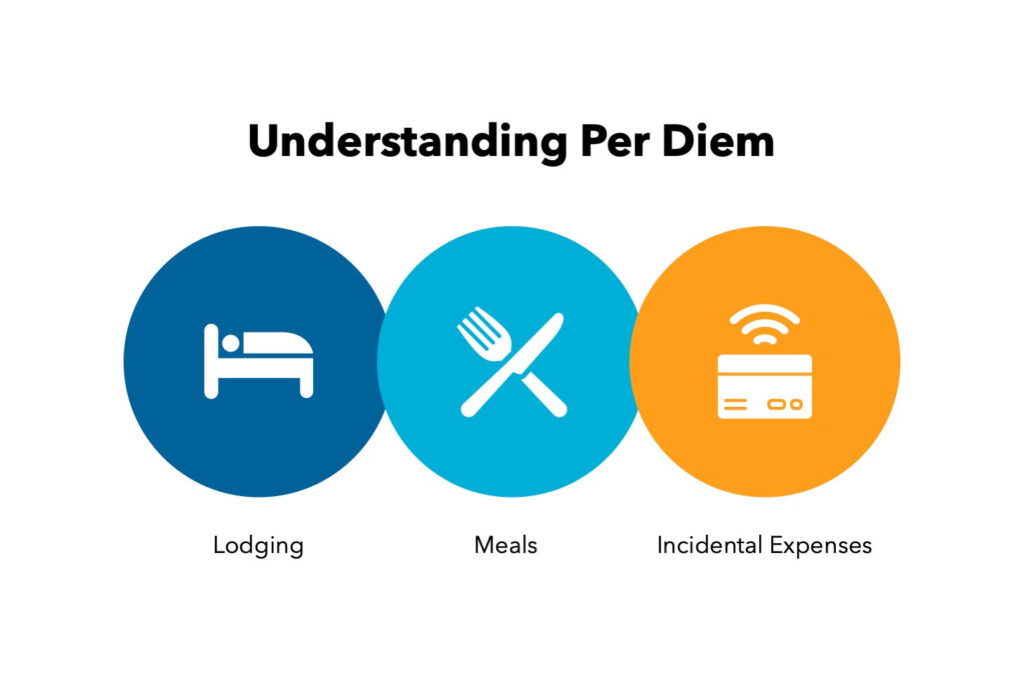Understanding Per Diem: Rates, Reimbursement, and FAQs
When embarking on a business trip, understanding the concept of use the per diem becomes crucial. This term refers to a daily allowance provided to employees to cover lodging rates, meals, and incidental expenses while away on official duties. The General Services Administration (GSA) sets the per diem rates based on location and fiscal year.

What does per diem mean?
Per diem is a daily allowance given to an employee to cover business travel expenses such as lodging, meals and incidentals while traveling for the company. This reimbursement method simplifies the process for both the employer and the employee, eliminating the need for receipts for each expense incurred.
What is the origin of the term “per diem”?
The phrase “per diem” comes from Latin and means “per day”.
Overview of Per Diem
Per diem can be categorized into various types including per diem rates for lodging, meals and incidental expenses (M&IE). The system offers several benefits for both employers and employees, streamlining corporate travel expenses and ensuring compliance with internal revenue service (IRS) regulations.
Benefits of Per Diem Rates
The benefits of using the per diem rate are numerous, with one major advantage being the ease and convenience it provides during business travel. Employees get per diem without needing to file detailed expense reports, and organizations can adhere to standard per diem rates.
GSA Rates and Maximum Per Diem
The GSA sets standard rates for per diem allowances, ensuring consistency and fairness in reimbursements. These rates are crucial to avoid exceeding the per diem amount set by the GSA and comply with federal regulations.
Tax Implications of Per Diem
Understanding the tax effects of per diem rates is essential for both employers and employees. While per diem reimbursements are generally non-taxable, exceeding the per diem rates may have tax consequences. Employers need to be aware of these implications to ensure compliance with the Internal Revenue Service (IRS).
What are the different types of per diem?
Government per diem
Government per diem rates refer to the standard rates that the U.S. GSA establishes. Federal employees receive these rates, and other businesses often use these rates as well.
Per Diems for the Self-Employed
Self-employed workers get per diems for daily expenses when traveling for work. Adhering to IRS rates and meticulous documentation is crucial for tax compliance and maximizing benefits.
Corporate per diem
Corporate per diem rates are allowances provided by companies to their employees. These rates can vary from the federal rates based on the specific requirements of the business.
Per diem rates for international business travel
International per diem rates are provided by companies to employees traveling overseas. Employers modify these rates to accommodate varying expenses, including the cost of living differences, in different countries. The Department of State website lists all foreign per diem rates. Foreign per diem rates for the UK can be found here.
Per Diem Reimbursement
When it comes to reimbursement, employees must follow specific procedures to receive their allowances. The process includes submitting expense reports in accordance with the per diem policy, detailing business expenses incurred while traveling for business. Employers review these reports and then reimburse employees based on the approved per diem rates for their location and fiscal year.
Process of Receiving Per Diem
Receiving per diem involves employees keeping track of their expenses during business trips. They must accurately document their lodging, meals and expenses to qualify for reimbursement. Once the trip concludes, employees submit their expense reports to their employers for review and approval.
Reimbursement Methods
Employers typically reimburse employees for per diem expenses by direct deposit or check. The purpose of the process is to ensure that employees are promptly reimbursed for business travel expenses. It streamlines the financial aspect of work-related travel.
Receipt and Documentation
Proper documentation is essential when claiming reimbursement. Employees must retain receipts for all eligible expenses, such as hotel bills and meal receipts. This documentation acts as proof of expenditure and is crucial for both internal record-keeping and potential audits, especially when per diem expenses are involved.
FAQs
Understanding per diem is critical, but there are common questions that arise regarding per diem. Here are answers to the most frequently asked questions:
What is per diem?
Per diem refers to the daily allowance provided to an employee to cover expenses incurred during business trips.
How are per diem rates determined?
Per diem rates, often referred to as GSA per diem rates, are set by the General Services Administration for different locations and are based on the cost of lodging, meals, and expenses.
What does per diem payment cover?
A per diem payment typically covers costs such as lodging, meals and travel expenses during a business trip.
What are incidental expenses in per diem?
Incidental expenses in per diem include small costs such as tips, transportation, and other miscellaneous expenditures.
How can I receive per diem reimbursements?
To get reimbursements, employees need to submit a detailed expense report with receipts for the incurred expenses during the trip.
Are per diem rates set annually?
Yes, per diem rates are set annually by the GSA and may vary depending on the location and fiscal year.
What are the tax implications of per diem?
The IRS provides guidelines on the tax treatment of per diem allowances, and it’s essential to understand the tax implications when using per diem.
Can per diem rates exceed the standard rate?
Per diem rates may exceed the standard rate in certain circumstances, such as high-cost locations or special travel requirements.
What are the benefits of using per diem for business travel?
The use of per diems for business travel simplifies expense management, ensures compliance with reimbursement policies, and provides employees with a clear per diem rate.
How are per diem rates set by the GSA?
The GSA determines daily allowance rates based on factors like accommodations expenses.
All HOW DO I pages
- How do I …
- How do I build a successful Corporate Travel Program for my company?
- How do I become a corporate travel manager?
- How do I become an executive assistant?
- How do I book group travel?
- How do I pack for a business trip?
- How do I understand per diem rates?
- What is a Global Distribution System?
- How do I pop ears after flight?
- How do I make travel arrangement as administrative assistant?
- How do I get corporate hotel rates?
- How do I cancel a hotel reservation?
- How do I get a frequent flyer number?
- How do I cut business travel costs?
- How do I build a better travel management company RFP?
- How do I get a handle on total travel spend?
- How do I keep my business travelers safe?
- How do I make business travel easier?
- How do I travel responsibly?
- How do I plan a travel program that remains relevant and engages travelers?
